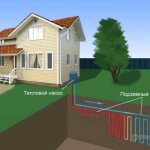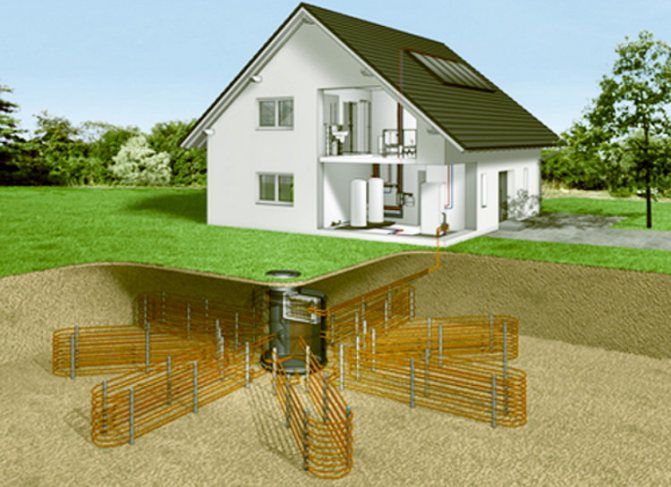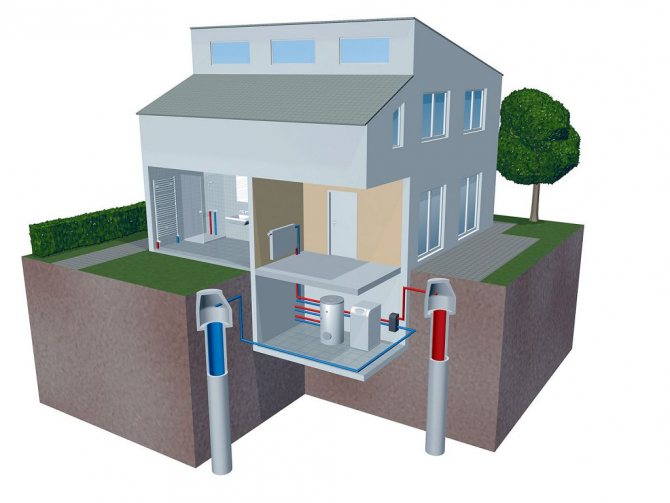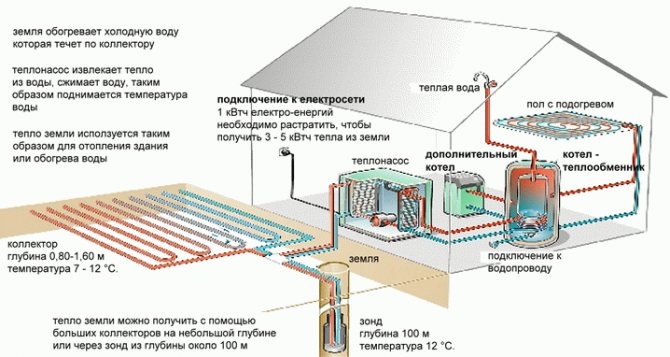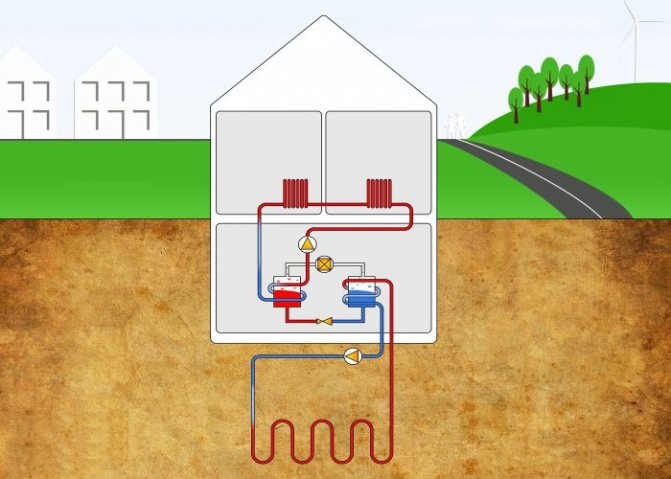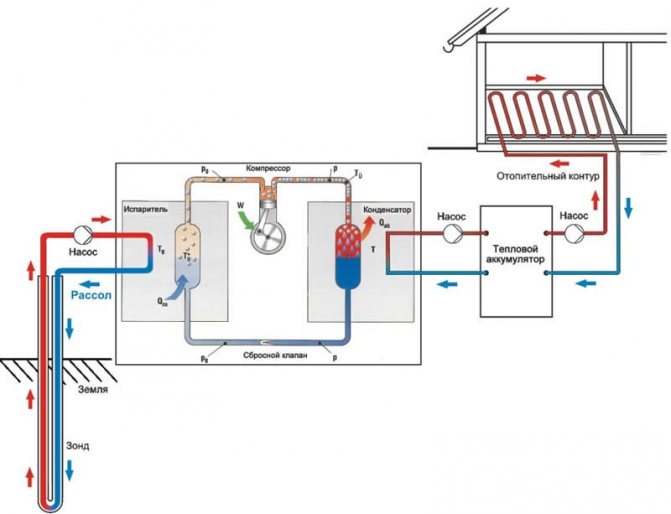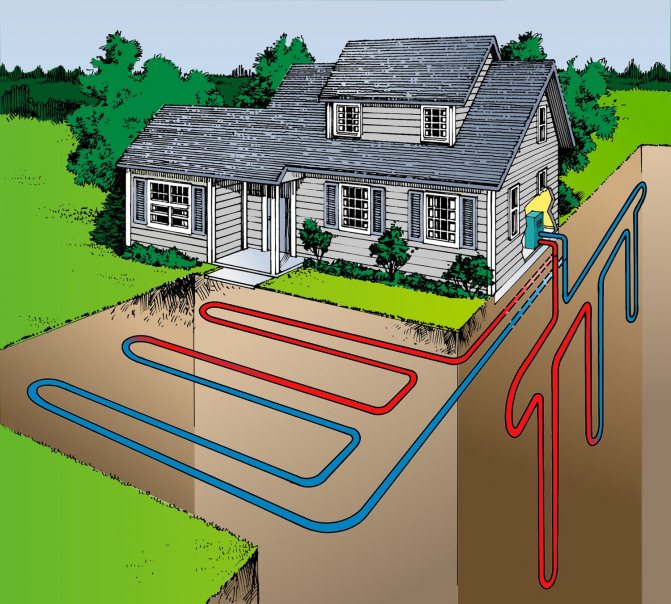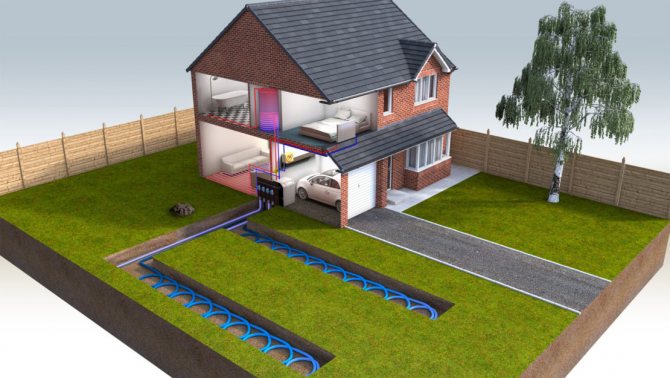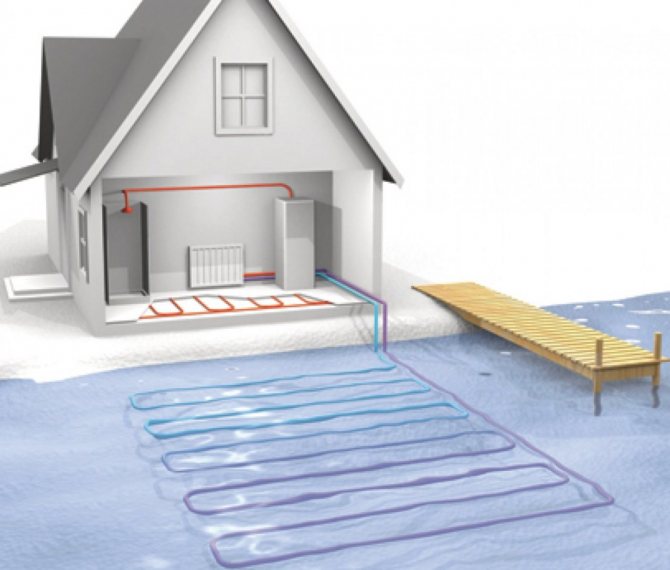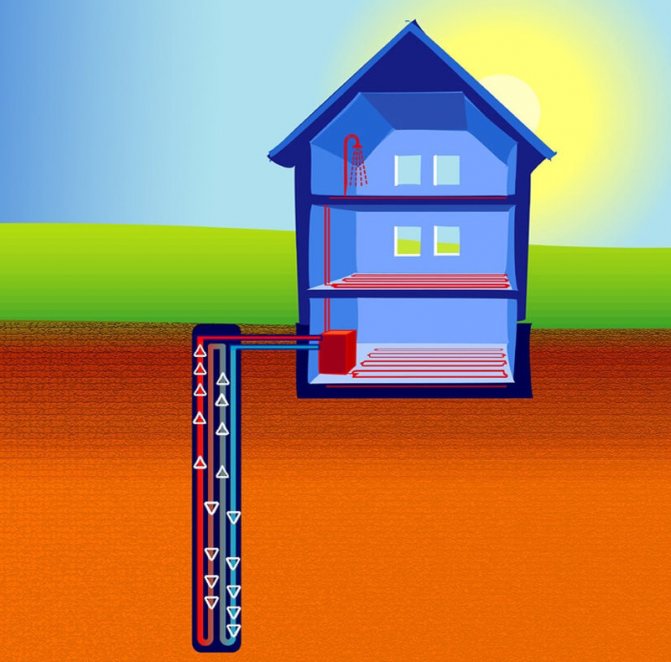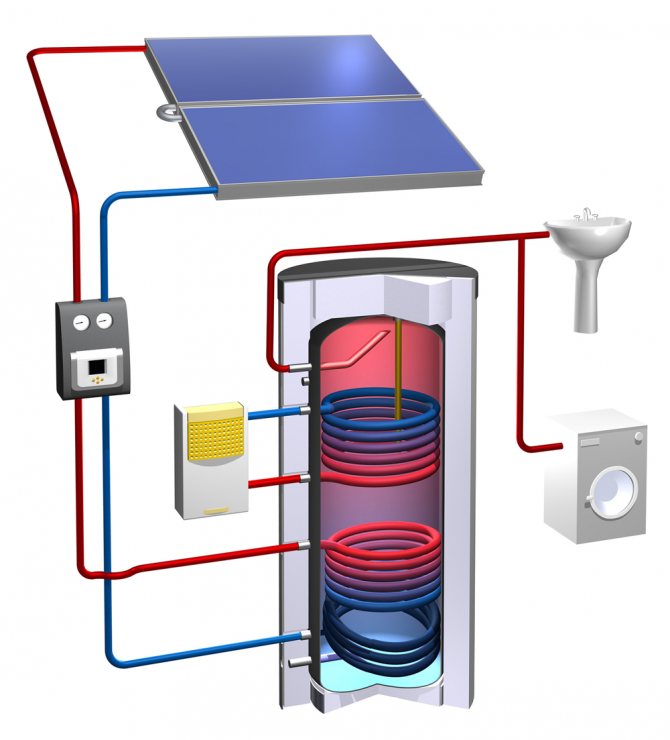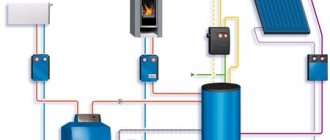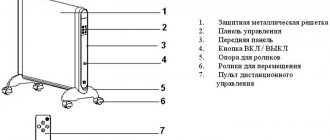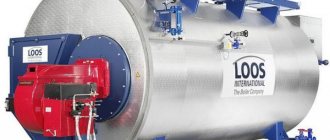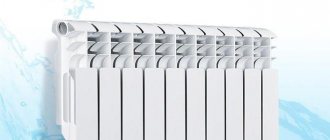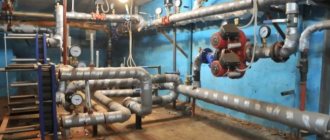To provide a private house with heat, units that run on electricity, solid, gas or liquid fuels are traditionally used. In recent decades, solar collectors and the heat of the earth's interior have been used as an alternative source of thermal energy. Heating a home with the heat of the earth is called geothermal home heating.
Geothermal heating of the house using the energy of the earth
Heating from the ground is in growing demand, as the cost of conventional energy sources steadily increases, while the reserves of fossil fuels are decreasing. Investing money in earthen heating of a country cottage is quite profitable, taking into account the economic prospects and significant savings on autonomous heat supply during the heating season.
Methods for obtaining natural thermal energy
Ground source heat pumps differ in the way they extract heat:
- Installations that use the heat of deep groundwater, hot geysers, etc.
- Systems that include an antifreeze tank installed in the ground at a depth of 75 meters. Heating from the bowels of the earth is provided by natural heating of the tank with antifreeze; As a result, the refrigerant, passing through the heat exchanger, gives up the received heat and returns to the container.
- The geothermal circuit is laid along the bottom of the reservoir, which is a natural heat accumulator. In this case, you need to take into account that the reservoir can completely freeze through in winter.

Types of ground source heat pumps
Heating a house with the energy of the earth requires extensive work on the installation of the system, but it is an environmentally friendly way to get almost free thermal energy. To heat a house, you will need a small amount of electricity required for the system to function.
Estimated costs and payback of the system
Choosing thermal heating, the principle of which is already known, the owners should be aware that certain investments will be required. The brand of equipment is selected according to the user's requirements, the price of the units depends on many factors, for example, power.
Devices for 4-5 kW are estimated at $ 3000-7000, for 5-10 kW they cost $ 4000-8000, for 10-15 kW it is already $ 5000-10000. Plus 40-50% of the amount will be the cost of installation work and system start-up. The result is a very impressive amount of costs. But all of them will pay off in about 3-5 years, and then only the electricity bills remain, which will be consumed by the heat pump.
Operating principles of geothermal heating
Heating from the energy of the earth is successfully used in various climatic zones: the systems are capable of operating in both the southern and northern regions.
In the course of its operation, a geothermal installation uses such a physical property of some fluids as the ability to evaporate, which leads to cooling of the surface. It is this phenomenon that underlies the operation of refrigeration equipment.
The principle of operation of geothermal heating is a reverse-run cooling process. This is how air conditioners work, capable of not only cooling, but also heating the air in the room.


How the heat pump works
However, air conditioning units have limited functionality - they cannot function at temperatures below -5 ° C. And the geothermal system is able to provide heating of the house regardless of the air temperature on the surface.This is due to the fact that in the environment from which it takes heat energy, stable temperature conditions are naturally maintained.
Output
The use of heat pumps allows you to get rid of the more expensive traditional fuels every year, although the initial costs will be quite high. Installation of geothermal heating can be carried out independently, only when installing pipes in a mine shaft, it is advisable to extinguish an assistant.
The payback of the project depends on the insulation of the housing, as well as the heating method - radiator or warm floors. The video in the article will provide an opportunity to find additional information on the above topic.
Did you like the article? Subscribe to our channel Yandex.Zen
Geothermal heating system device
Geothermy (the science of the thermal state of the Earth) made possible the practical use of thermal energy that the earth's crust receives from the hot magma in the center of the planet.
A specially designed heat pump for heating a house is installed on the surface, and a heat exchanger is mounted in the ground or at the bottom of the reservoir. Thermal energy is "pumped out" to the surface and allows you to heat the coolant in the heating circuit of a house or non-residential facility.


How is the heating process
Geothermal heating of a private house is a cost effective option. If you use the energy of the earth to heat a house, then for every kilowatt of electricity required for the operation of the equipment, there are 4 to 6 kW of useful thermal energy obtained from the bowels of the planet.
In comparison with the operation of the air conditioner, we will see that during its operation, more than 1 kW of electricity is required to obtain 1 kW of thermal energy. This is due to the inevitable losses for converting one energy into another, etc.
It is very profitable to heat a residential building using the thermal energy of the earth's interior, but the payback period for equipment and installation costs will take some time.
Using the heat of the earth to heat a house does not require the installation of a traditional boiler to heat the coolant.
In this case, the system consists of three components
:
- heating circuit - geothermal source of thermal energy;
- heating circuit inside the house - low-temperature radiator or floor;
- pumping station - a heat pump for pumping heat energy into the heating circuit from the heating circuit in the soil or under water.
A geothermal heating system can also be used to heat greenhouses, ancillary buildings, pool water, garden paths, etc.
Types of geothermal installations
Having figured out what geothermal heating at home is, the principle of operation of the equipment, we will consider the types of systems.
In total, there are 3 types of installations:
- Ground-water is considered to be the most efficient system for heating living quarters. The principle of operation is reduced to the consumption of heat from the ground by means of probes, collectors and the transfer of energy to a heating system with a water heat carrier.


Purpose and principle of operation of the hydraulic switch for heating
- Water-water uses a warm-water resource as energy. To ensure the functionality of the system, a source is needed (pond, river, lake). Experts note that this design is the most stable in terms of temperature.
- Air-air uses an unlimited and available natural reserve for work. The functionality of the system is provided by fans, evaporators connected into one complex. The greatest efficiency is achieved at temperatures down to -15 C; when the air gets cold, part of the system's power is lost.
Equipment for the arrangement of geothermal heating
Geothermal equipment for a deep heating system allows accumulating thermal energy extracted from the environment and transferring it to the heat carrier in the heating circuit.
The list of equipment for heating with heat from the earth includes
:
- Evaporator. The device is located at a depth, and it serves to absorb thermal energy located in geothermal waters or soil.
- Capacitor. Allows you to bring the temperature of the antifreeze to the value required for the functioning of the system.
- Heat pump. Provides circulation of antifreeze in the heating circuit, controls the operation of the geothermal installation.
- Buffer tank - a container for collecting heated antifreeze. Allows you to transfer thermal energy of the earth's interior to the coolant. The tank through which the coolant passes is equipped with a coil-shaped heat exchanger. Heated antifreeze moves along it, giving off heat.


Heat pump device diagram
How to make a geothermal unit with your own hands?
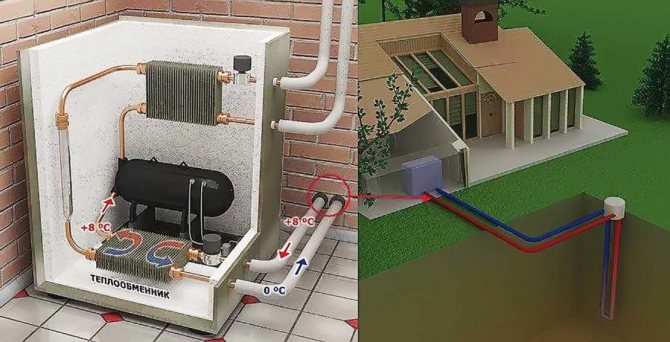

To make geothermal heating at home with your own hands, you will need the following components:
- evaporator;
- compressor unit;
- throttle valve;
- capacitor.
A heat pump can be made from an old refrigerator. For this, the coil is removed from it. It will act as a capacitor. It is placed in a container made of durable material. A compressor is attached to the container, and the evaporator is made from a plastic barrel. All the constituent elements are connected to each other, and then the unit is connected to the heating system of the house using polymer pipes.
To make a pump from an air conditioner, the outdoor and indoor units must be swapped. Water or air is used as a heat carrier. The system is equipped with a four-way valve. To install it, you will need the help of specialists.
System installation
Geothermal heating of a country house at the stage of arrangement requires a solid investment. The high total cost of the system is largely due to the large amount of land work associated with the installation of the heating circuit.
Over time, the financial costs pay off, since the thermal energy used during the heating season is extracted from the depths of the earth with minimal energy consumption.
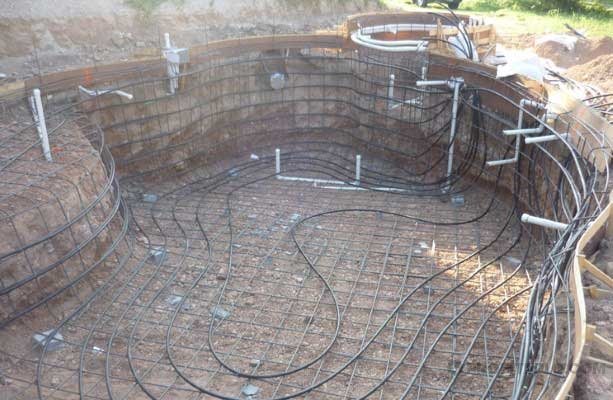

Installation of a horizontal heat exchanger for a geothermal heating system
To provide heating of the house with the heat of the earth, installation of the system is required
:
- the main part should be located underground or at the bottom of the reservoir;
- in the house itself, only sufficiently compact equipment is installed and a radiator or floor heating circuit is laid. The equipment located inside the house allows you to regulate the heating level of the coolant.


What does geothermal equipment look like in a home
When designing heating using the heat of the earth, it is necessary to decide on the installation option for the working circuit and the type of collector.
There are two types of collectors
:
- Vertical - plunges into the ground for several tens of meters. To do this, at a short distance from the house, you need to drill a number of wells. A contour is immersed in the wells (the most reliable option is cross-linked polyethylene pipes).
- Disadvantages: Large financial costs for drilling several holes in the ground with a depth of 50 meters.
Advantages: The underground pipe location at a depth where the ground temperature is stable, provides a high efficiency of the system. In addition, the vertical collector takes up a small area of the land plot.
- Horizontal. The use of such a collector is allowed in regions with warm and temperate climates, since the depth of soil freezing should not exceed 1.5 meters.
- Disadvantages: The need to use a large area of the site (the main disadvantage).After laying the contour, this piece of land cannot be used for a garden or vegetable garden, since the system works with the release of cold when transporting refrigerant, which will cause the roots of the plants to freeze.
Benefits: Cheaper land work that can even be done on your own.
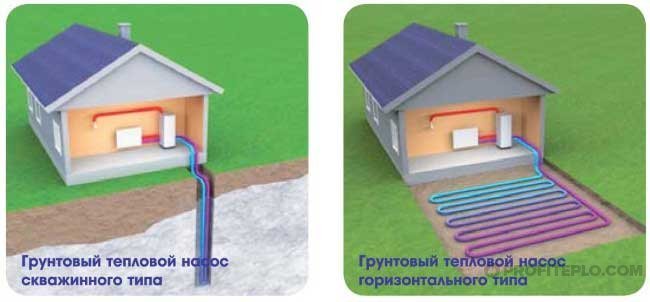

Horizontal and vertical collector type
Geothermal energy can be obtained by laying a horizontal geothermal circuit at the bottom of a frost-free reservoir. However, this is difficult to implement in practice: the reservoir can be located outside the private territory and then the installation of the heat exchanger will need to be coordinated. The distance from the heated object to the reservoir should be no more than 100 meters.
Important! The ambient temperature of the collector must not fall below + 5 ° C. The upper part of the collector in contact with the freezing soil must be protected with thermal insulation to avoid loss of thermal energy.
